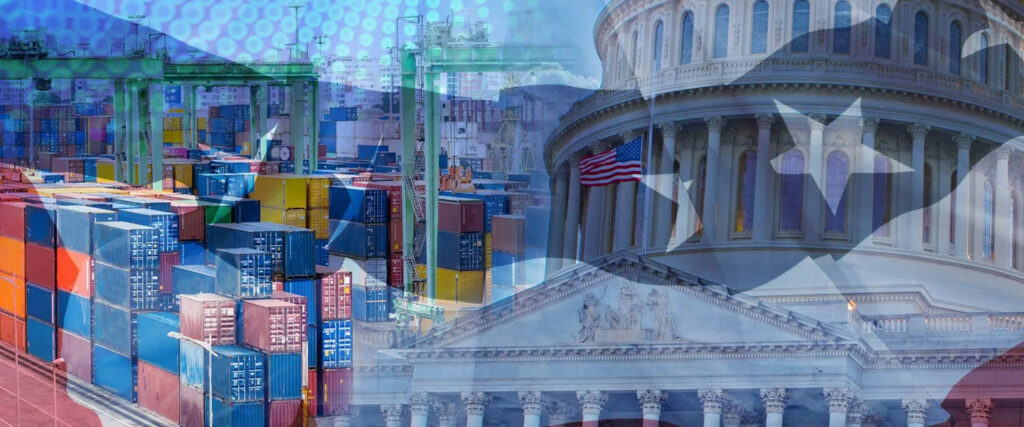By: Jock Finlayson

On April 3, the world awoke to a fundamentally altered trade landscape with the announcement of sweeping U.S. “reciprocal” tariffs on goods imported from almost every country on Earth—both “friends and foes,” as President Donald Trump memorably put it.
Almost all foreign suppliers to the United States will face a minimum 10 per cent tariff, with roughly 60 countries in line for higher tariffs based on the evident sin of running sizable trade deficits with the U.S. Japan, South Korea, Taiwan, Switzerland, the European Union and India are among the U.S. trading partners in the latter group; they will now encounter virtually across-the-board American tariffs of 20-35 per cent. Chinese goods shipped to the U.S. will be greeted by a 34 per cent tariff, on top of previously imposed levies on various categories of Chinese-made products.
For now, Canada and Mexico are spared these reciprocal U.S. tariffs, prompting polite sighs of relief in policy and business circles in both countries. Instead, America’s North American neighbours will continue to be charged 25 per cent U.S. tariffs on goods deemed to be non-compliant with the rules of origin in the Canada-United States-Mexico Agreement (CUSMA) negotiated during Trump’s first presidential term. Since most traded goods can meet CUSMA’s compliance test if the producers are willing to complete the necessary paperwork, in practise the bulk of Canada’s exports to the U.S. should enjoy tariff-free access. In present circumstances, that’s something to celebrate.
However, Canadian (and Mexican) aluminum and steel producers, along with vehicle and parts manufacturers, will have to manage separate 25 per cent American tariffs. The tariff charged on Canadian-made autos is to be set at a lower 12.5 per cent rate, provided they contain at least 50 per cent American content. As this was being written, Canada’s federal government had unveiled retaliatory tariffs on imports of motor vehicles (but not auto parts) from the U.S., matching the levies Ottawa announced a few weeks ago on imports of steel, aluminum and other products from the U.S.
President Trump’s tariff barrage is unprecedented in scope and scale. According to one source, it will increase the weighted average U.S. import tariff by 23 percentage points, lifting it above the level of the 1930s. At least Canada will face a materially lower average tariff rate on its exports of goods to the U.S. than other American trading partners.
The sharp protectionist turn of U.S. trade policy is sure to trigger retaliation by many countries targeted by America’s helter-skelter import levies. All of this signals the final demise of the multilateral global trading system built—largely under U.S. leadership—in the decades following the Second World War. That system has been under stress for some time. It rested on three key pillars: respect for relatively open markets, a desire to encourage and expand international commerce, and a commitment to “non-discrimination” among trading partners embodied in the most-favoured-nation principle. That old trade regime now lies in ruins.
Today, the U.S. is seeking to accelerate the trends toward “de-globalization and regional fragmentation” that gathered force in the wake of the 2008-09 global financial crisis. President Trump embraces an explicitly mercantilist understanding of international trade, one that conceives of cross-border commerce in zero-sum terms: if two parties resident in different countries exchange goods (or services), only one—the exporter—benefits while the other ends up worse off. The question naturally arises why the latter party would undertake the transaction in the first place, if doing so serves to diminish its own economic welfare. This is not a question that troubles the president or his acolytes who, when it comes to international trade, apparently prefer the socialist central planner’s playbook to the ideas of Adam Smith, David Ricardo and their intellectual descendants.
Investors have already given President Trump’s tariff scheme an unambiguous thumb’s down, with equity markets falling in the weeks prior to his “Liberation Day” news conference and then plunging further as the details became known. Forecasters are rushing to revise their outlook for the giant U.S. economy, with leading prognosticators now expecting slower growth, higher inflation and eroding business and consumer confidence over the balance of 2025 and into next year. The risk of a U.S. recession is now far greater than it was before President Trump was sworn into office in January 2025. Global economic growth is also poised to suffer a significant blow as the tariff madness spreads.
Tariffs ultimately act like a tax on the imports to which they apply—both consumer products and intermediate business inputs such as steel, equipment and raw materials. While the foreign suppliers of tariffed goods will bear some of the cost of President Trump’s tariffs, a substantial portion of the burden is destined to fall on American households and businesses. Last year, U.S. imports were valued at roughly $3.3 trillion. The same imports will now cost Americans several hundred billion dollars more, inevitably pushing up inflation. While the cash-strapped U.S. Treasury will collect more tariff revenue, any benefit will be more than offset by the pain inflicted on the wider American economy.
President Trump’s tariffs are a case study in “intentional self-harm,” driven by an inward-looking political and economic ideology that distrusts the outside world and aspires to reduce America’s engagement with and dependence on other countries. It is unlikely to end well.
Share This:





 CDN NEWS |
CDN NEWS |  US NEWS
US NEWS 




























